Dachshund Dog Breed Information and Temperament
The Dachshund, also known as the badger dog or sausage dog, stands out with its unique long body and short legs, a distinctive shape initially bred in Germany for their role in hunting.
The Dachshund, sometimes likened to a spirited terrier because of their bravery and persistence, doesn’t shy away from a challenge, reflecting their bold temperament. Dachshunds sport three coat types, similar to those of a terrier: smooth, long-haired, and wire-haired, each demanding different grooming routines.
Despite their diminutive size, often likened to a wiener dog, Dachshunds possess a lively and self-reliant temperament.
They can quickly adapt to living in smaller spaces like apartments, but keeping an eye on their health, especially their backs, to prevent spinal problems is essential. A healthy diet and regular exercise, just like in most popular dog breeds, are vital for Dachshund’s well-being.
Known for their strong attachment to their owners, Dachshunds, commonly known as sausage dogs, offer a perfect mix of affection and vivacity, making them one of the most popular family dogs.
Key Takeaways
- Dachshunds have a distinctive shape for historical hunting roles.
- Three coat types affect their grooming needs.
- They thrive in small spaces but watch their back health.
Initially bred for hunting, Dachshunds boasts a unique long body and short legs. These courageous dogs come in smooth, long-haired, and wire-haired coats, each with its grooming routine. Despite their small size, Dachshunds are spirited and self-sufficient, suitable for apartment living if their spinal health is monitored and they exercise regularly. They form strong bonds with their owners, offering a blend of affection and energy.
Quick Facts
Known for its unique shape and lively nature, the Dachshund is a German breed that has transitioned from a skilled hunting dog to a cherished pet. These dogs come in three coat types—smooth, long-haired, and wire-haired—to suit various climates and tasks. They are also available in standard and smaller miniature sizes, about the same size as a tiny French pointer.
Despite their strong personalities, dog may face health challenges such as intervertebral disk disease (IVDD) due to their long backs. They typically live between 12 to 16 years, offering dedicated friendship to their owners.
Dachshund Pictures

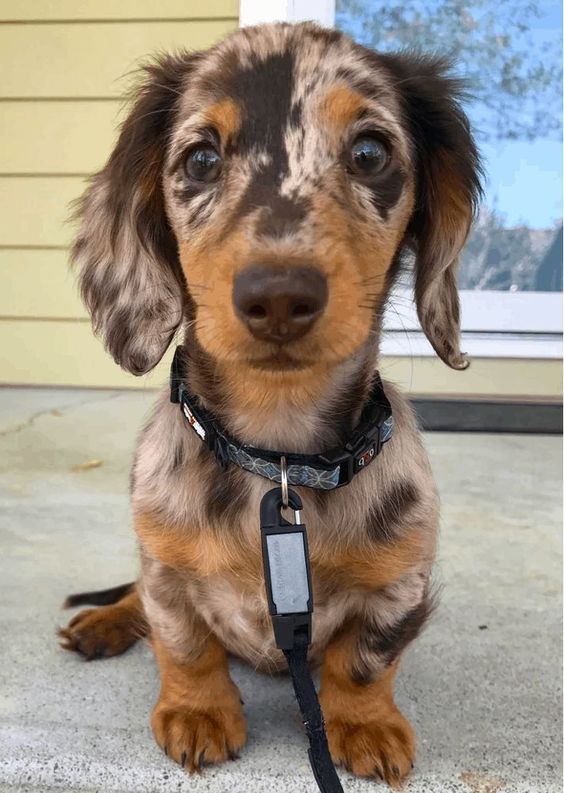


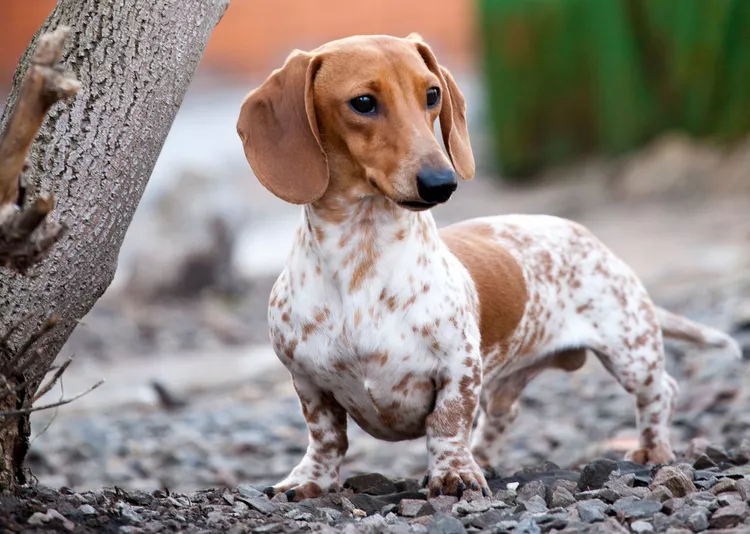
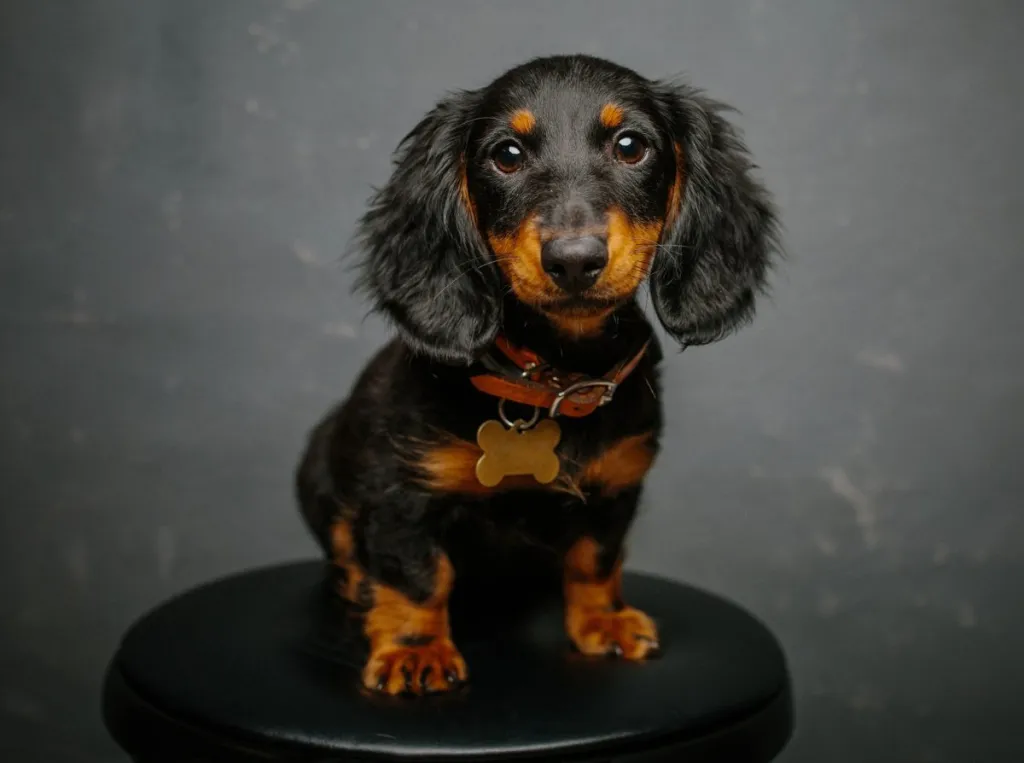
Overview
The Dachshund is easily recognized by its unique shape, designed for an adventurous past of tracking down animals in narrow settings. This breed’s charm has made it incredibly popular, securing the 9th spot on the American Kennel Club’s popularity list.
Dachshund rescues are available in standard and miniature sizes to fit home environments and owner preferences. The more extensive standard dachshund measures about 8-9 inches tall and weighs 16-32 pounds, while the smaller Miniature stands around 5-6 inches and weighs less than 11 pounds.
These dogs also feature three distinct coat variations: smooth, long-haired, and wire-haired, each requiring a different grooming approach.
Owners can expect to enjoy their company for 12-16 years, although their playful and independent nature might make training challenging.
Key Features
The Dachshund stands out with its long body, short legs, and various coat types that serve practical needs and contribute to their distinctive look. These intelligent and lively dogs come in standard and miniature sizes, catering to different hunting tasks and being loyal pets. Their design provides them with the ability to move swiftly and dig effectively, but it also puts them at risk for back issues, such as intervertebral disc disease.
Here’s a brief on their physical features and coat options:
| Feature | Description | Notes |
|---|---|---|
| Body Shape | Lengthened | Vulnerable to back problems |
| Coat Varieties | Smooth, Long-haired, Wire-haired | Each requires certain grooming practices |
| Sizes | Standard, Miniature | Standard (8-9 inches), Miniature (5-6 inches) |
Dachshund owners should proactively care for their pet’s spine and maintain the smooth, long-haired, or wire-haired coat.
Breed Origins
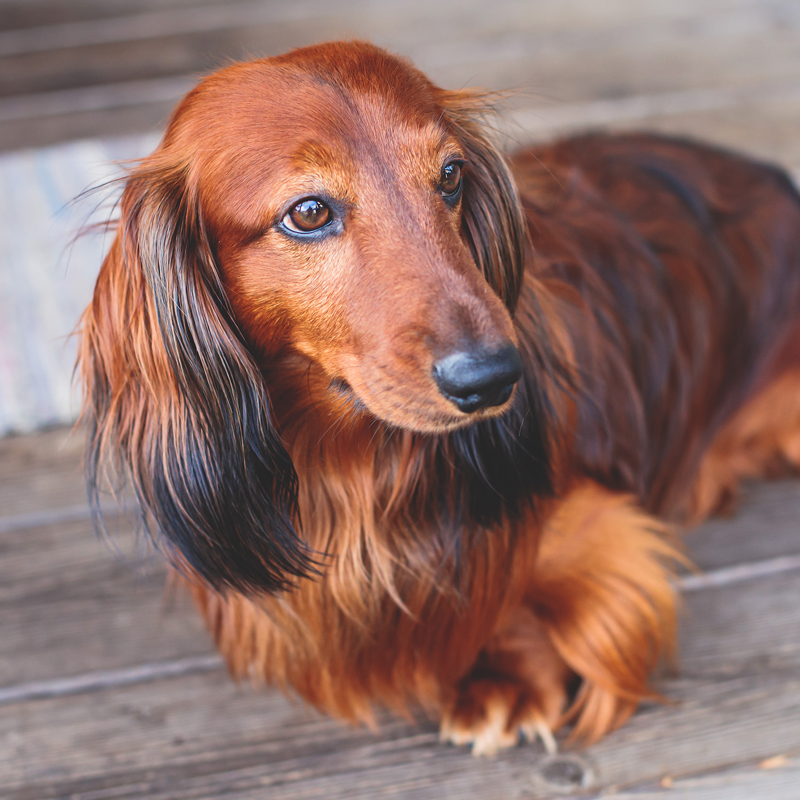
The Dachshund is significant in Germany’s past, emerging as a breed honed for the hunt. Its ancestry includes a mix of European hounds and terriers, skillfully bred to excel in tracking prey. Knowing where the Dachshund comes from enhances our understanding and appreciation of its distinct traits.
- Careful selective breeding is evident from historical records.
- The breed’s creation is deeply linked to Germany’s rich hunting heritage.
- The Dachshund’s bloodline was drawn from various European dogs.
- Its intentional design for hunting has maintained its popularity and adaptability.
Historical Breed Development
The Dachshund originated in Germany and was developed by combining traits from hounds and terriers. This resulted in a dog that was a skilled hunter, proficient in pursuing various types of prey. The breed’s name, which translates to ‘badger dog,’ reflects their initial role in hunting. These determined dogs excelled at burrowing into badger dens.
In their early days, German dachshunds were bigger and suited to hunt sizable animals like wild boar and even track wounded deer thanks to their acute sense of smell and enduring stamina. As hunters shifted focus to more miniature games, the Dachshund’s size decreased, leading to the more compact versions commonly seen now. These adaptations highlight the breed’s versatility and the adjustments made to meet changing hunting needs.
Originating Country Discovery
In Germany, hunters have long valued the Dachshund for its underground hunting skills, central to the breed’s history. Known as the ‘badger dog,’ the Dachshund was bred to hunt badgers by tracking their scent and bravely entering their burrows.
The original German dachshunds were larger, built to take on the challenging task of hunting. Over time, breeders have refined the Dachshund’s senses and build, creating a smaller dog with a muscular build, ideal for fitting into tight spaces while hunting.
Ancestral Lineage Tracing
Tracing the ancestral lineage of the Dachshund takes us back to 18th-century Germany. Here, breeders carefully developed the Dachshund for hunting, shaping traits like their distinctive long bodies and strong legs to fit into burrows and bravely face badgers. These features made them excellent at their job.
As time went on, dachshunds were not just hunters but also became favored pets in European royal courts. They proved adept at hunting various game, from rabbits to deer, showcasing the breed’s adaptability and valued place in history.
The development of the Dachshund in Germany shows a deep-rooted history that continues to influence the dog breeding world today.
Physical Dimensions
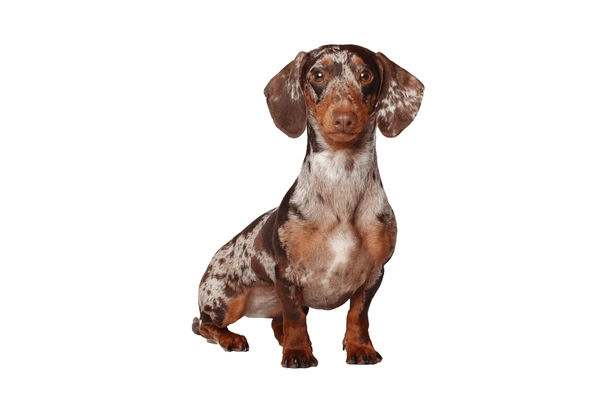
Dachshunds are known for their distinctive shape, featuring a long body and short legs. This design is not just for looks; it plays a role in their agility and movement.
Different varieties within the breed include the standard and miniature sizes, and they showcase a variety of coat lengths, adding to the Dachshund’s versatility in both function and style.
The size of a Dachshund can vary, with some as light as under 5kg and others weighing over 14kg. Their height at the shoulders also changes according to their size category. The muscular build of a Dachshund is part of what gives them their iconic silhouette.
As for their coats, they come in three types: smooth, long-haired, and wire-haired, each offering a different look and feel to the breed.
Breed Size Range
Dachshunds come in two sizes to suit different lifestyles and preferences.
Standard Dachshunds typically measure 8-9 inches tall and weigh between 16-32 pounds, while miniature Dachshunds are more diminutive, standing around 5-6 inches tall with a weight under 11 pounds. These size variations help potential owners choose a family pet that fits well into their home environment.
Maintaining the size standards for Dachshunds is vital for the dogs’ health and the breed’s overall quality. Breeders must follow these guidelines closely to ensure that the puppies, especially those from the miniature variety, are healthy and display the breed’s distinct characteristics, avoiding any issues that might arise from careless breeding.
Weight and Height
Knowing the size and weight of dachshunds helps breeders and pet owners keep them healthy and up to breed standards. A standard dachshund stands about 8-9 inches tall and should weigh between 16-32 pounds. The miniature version, smaller in size, measures around 5-6 inches in height and should weigh no more than 11 pounds. The kaninchen, the tiniest variation, has a weight range of about 3.5kg to 5kg.
These dogs are known for their deep chests, which house solid hearts and lungs. However, this feature, combined with their long backs, can make them prone to health issues like intervertebral disc disease. That’s why keeping an eye on their weight is vital, as it directly affects their spinal health and can prevent joint problems like patellar luxation.
Proper weight management goes beyond looks; it’s about keeping these charming dogs healthy.
Body Shape
Dachshunds are well-known for their long bodies and short legs, a shape that’s not just for looks but also serves a practical purpose. They have a deep chest that provides ample space for a healthy heart and lungs.
Their unique physique was shaped by their historical use as efficient hunters in narrow burrows. The Dachshund’s build allows them to navigate tight spaces with impressive agility and strength.
This combination of form and function showcases nature’s skill in creating animals that are both charming and ideally suited to their environments.
Coat Length Variations
Dachshunds come in three coat length variations, each with its own grooming needs.
Long-haired dachshunds have a glossy coats with extra fringes on their legs and ears, and they need regular brushing to prevent knots.
The short, smooth coat of smooth dachshunds is low-maintenance and needs a quick brush now and then to stay shiny.
On the other hand, wire-haired dachshunds sport challenging, wiry coats that require more care, including brushing and stripping, to keep them in good condition.
These grooming differences highlight the dachshund breed’s adaptability and range of physical attributes.
Standard Vs. Miniature
Understanding the size differences between standard and miniature dachshunds is crucial for breeders and owners to provide appropriate care and honor the breed’s standards.
According to the Dachshund Club of America and the American Kennel Club, a standard dachshund typically stands between 8 and 9 inches high and weighs 16 to 32 pounds. On the other hand, miniature dachshunds are smaller, with a height of 5-6 inches and a weight not exceeding 11 pounds to fit the breed’s guidelines.
Originally bred to be versatile hunters, dachshunds come in three coat types and various sizes. Whether standard or miniature, all dachshunds need regular exercise to stay healthy and happy.
Behavioral Traits

Dachshunds have distinctive behaviors that their owners should manage attentively. It’s essential to address their strong prey drive and tendency towards separation anxiety to maintain their happiness and ensure the safety of other pets. Proper training and socialization can prevent problems and make living with these energetic dogs more enjoyable.
Managing Prey Drive:
Structured playtime and safe environments are essential.
Socialization Tips:
Introduce them early to different people and pets for better adjustment.
Reducing Excessive Barking:
Use rewards to teach them when it’s okay to bark.
Alleviating Separation Anxiety:
Establish a comforting routine to help them feel secure when they’re alone.
Prey Drive Management
Training a dachshund to manage its hunting instincts is crucial for a peaceful home and for protecting local wildlife. These dogs have a solid drive to track and chase, so owners should start training early to channel their energy appropriately.
Teaching them obedience and how to manage impulses helps positively direct their instincts. It’s also vital to socialize them so they can get along with different animals and adapt to various settings.
A consistent and understanding approach is critical to helping these energetic dogs behave safely and become loving family members.
Socialization Techniques
Training a dachshund to be sociable is a tailored approach that acknowledges their natural tendencies. For example, dachshunds may be a bit wary of new faces and might have a defensive reaction towards kids they don’t know. These dogs can sometimes be shy, hindering their ability to mingle confidently with people and other pets.
To overcome these challenges, starting socialization early and doing it regularly is essential. This means encouraging friendly encounters and introducing them to various settings and scenarios. By exposing them to different people, places, and situations, you can help them become more comfortable and confident in social interactions.
Watching kids’ interactions closely and guiding them as needed is vital. Teach children how to approach and interact with the Dachshund appropriately, emphasizing the importance of being gentle and respectful. This will help prevent any negative experiences and build positive associations with children.
Your Dachshund can grow into a friendly and well-behaved pet with patient and understanding training. Remember always to be consistent, reward positive behavior, and seek professional guidance if needed.
Barking Tendencies
Dachshunds are known for their loud barking, a natural behavior from their past as hunting dogs. They use barking to alert their owners to anything unusual. Each Dachshund has a unique personality; some might bark more often, while others are quieter. Keeping a dachshund mentally and physically active is critical to managing their barking habits. This is true no matter the color of their coat or if one Dachshund, let’s call him Fido, barks more than his peers.
These dogs’ barks are not just noise; they show their bold spirits and desire to protect their homes. With regular training and patience, you can teach your Dachshund when it’s okay to bark. You can enjoy their playful and loyal company without too much noise.
Separation Anxiety Solutions
Addressing separation anxiety in Dachshunds involves behavioral training and active participation from the owner. It’s crucial to acclimate your pet to being alone by starting with brief absences and then gradually increasing the time you’re away.
Consistent training and early socialization will boost your Dachshund’s confidence and can prevent anxiety. To keep their mind off your absence, offer calming treats or fun toys that can hold their attention.
Regular physical and mental exercise is essential because a tired and content Dachshund is likelier to stay calm when you’re not there.
Tailoring separation anxiety strategies to fit your dog’s needs will yield the best results.
Training Challenges
Dachshunds often show a stubborn side, making obedience training more challenging. They were bred to hunt, which gives them a strong will, but this can lead to resistance when learning new commands. Trainers must be patient and develop creative methods to engage these spirited dogs and constructively direct their energy. If a dachshund feels overwhelmed or mishandled, they might become irritable or even snap.
If a Dachshund doesn’t get enough exposure to different people and situations, Hansling becomes too shy or aggressive. Handling their training with a balanced, kind, and assertive approach is vital. Grooming sessions, including brushing to remove loose fur, are also perfect moments to teach your Dachshund and strengthen your mutual bond.
Health Concerns & Maintenance

Dachshunds are known for their unique shape, but this also means they have specific health needs that owners should be attentive to. Keeping these dogs healthy involves a proactive approach, including regular vet visits and tailored care plans.
Managing the risk of intervertebral disk disease (IVDD) is critical for these breeds, as they are highly susceptible due to their elongated spines. Ensuring a balanced diet and exercise regimen helps prevent obesity, which can put extra strain on their backs. It’s also wise to check their joints regularly to catch any signs of patellar luxation early.
Lastly, don’t overlook their eyes; routine eye exams can spot issues before they become serious problems.
Common Dachshund Diseases
Dachshunds are often affected by intervertebral disk disease (IVDD), a significant health issue due to their long spines. Owners must watch for back pain or paralysis signs, as these active dogs can sometimes be overly adventurous, increasing their injury risk. Early screening for IVDD in puppies, keeping a close eye on their weight, and ensuring they play safely can help prevent problems.
Dogs with the double dapple pattern, known for their distinctive merle coat, can be more susceptible to hearing and sight loss issues. It’s vital for breeders to follow ethical practices and for owners to keep up with regular vet visits. Creating a caring home environment is also essential for the health and happiness of these lively pets.
Preventive Health Measures
Dachshund owners should make regular vet visits and exercise plans that suit this breed’s specific needs to keep them healthy. Originating from Germany as skilled hunters, these ‘badger dogs’ have unique needs. In the U.S., the Dachshund Club of America advises against letting these dogs jump or climb stairs excessively to avoid spinal injuries. Instead, they recommend daily walks and activities that strengthen muscles while gentle on the spine.
Keeping a healthy weight is vital for Dachshunds to avoid obesity, which can lead to intervertebral disk disease (IVDD). Owners should carefully control their pet’s diet. Grooming varies among Dachshunds, but those with long hair must brush twice weekly to prevent tangles and keep their skin healthy.
Lifespan and Care Strategies
Dachshunds aged 12 to 16 need a well-thought-out care plan to keep them healthy and happy. When you welcome a dachshund puppy into your home, it’s vital to start preventive measures to protect them from spinal issues, such as intervertebral disk disease (IVDD). This means keeping them at a healthy weight and opting for harnesses over collars to reduce the strain on their backs. Regular vet visits are vital to catching other health issues early, like patellar luxation and heart problems.
Different coat types, especially in long-haired dachshunds, may require specific grooming routines to avoid tangles and matting. Dachshunds adapt well to living in apartments and thrive as part of a family. They need light exercise and plenty of love to stay physically and emotionally in good shape. This care ensures they can enjoy their life to the fullest.
Maintenance Requirements
Dachshunds have a distinctive shape and lively character, so they need a care routine tailored to their specific requirements. Grooming, regular activity, and proper nutrition are fundamentals to keep these dogs physically and mentally fit. It’s also vital to have routine vet check-ups and to maintain ongoing training for a well-balanced life.
Each Dachshund’s coat type demands a particular grooming approach to avoid tangles and skin problems. Exercise is vital, too, not just for their energy but also to help prevent back injuries that the breed is prone to. Feeding them the right amount of nutritious food will keep them at a healthy weight and help them dodge issues linked to obesity. Early and consistent training and getting them used to different people and environments is crucial in raising a friendly and well-mannered pet.
Grooming Needs
Grooming Needs
Proper grooming is vital for a Dachshund’s health and looks, with each coat type presenting its challenges. The smooth-coated Dachshund has the most straightforward grooming routine, benefiting from regular brushing to remove loose hair and keep their coat shiny.
On the other hand, long-haired and wire-haired varieties demand more effort. They need consistent combing to avoid knots and tangles, especially the long-haired ones. Wire-haired Dachshunds might also require the occasional hair stripping to clear away dead hair.
Those with distinct coat patterns, like the double dapple, require careful grooming to maintain their unique appearance.
Exercise Frequency
Exercise Frequency for Dachshunds
Keeping a Dachshund healthy goes beyond coat care; it includes a customized exercise plan that suits their active nature and helps prevent health problems.
These small dogs thrive on daily walks and playful activities, which help control their weight and keep their minds sharp. Using positive reinforcement when training them makes exercise enjoyable and rewarding.
Due to their unique body shape and long spine, it’s critical to exercise these dogs carefully to avoid harming their backs. Opt for harnesses rather than collars to distribute force better and prevent activities that could harm their spines.
Regular and careful exercise is vital to maintaining Dachshunds’ health and happiness.
Health Check-ups
Regular vet visits are critical for keeping Dachshunds healthy, mainly because of their tendency for back problems. These small dogs, with their distinctive long bodies and short legs, are a favorite among city residents who live in apartments. Yet, these same traits make them prone to conditions like intervertebral disk disease (IVDD) and patellar luxation.
It’s critical to have vets check them often, who can advise on keeping their weight in check and suggest safe exercises for spine care. Consistent health screenings are vital to catch and treat issues with their eyes, ears, teeth, and heart early, helping these cherished pets enjoy a high quality of life.
Diet Considerations
Dietary choices are vital to keeping a dachshund healthy, especially since these dogs are prone to spinal problems if they become overweight. Known for their unique long bodies, dachshunds are a favorite among those living in smaller spaces, like city apartments. Their limited space makes it crucial to control their diet.
As responsible pet owners, we must provide a balanced diet that meets their needs, including calories that suit their activity level. Staying away from too many snacks and people’s food, sticking to scheduled meal times, and getting advice from a vet are all ways to help a dachshund stay at a healthy weight and avoid health issues.
Training Commitment
Training a dachshund requires a good mix of consistency and patience due to their playful but willful personality. These energetic dogs need clear guidance and plenty of love to learn good behavior and avoid developing bad habits.
Dachshunds are available in various colors and three coat types: smooth, long, and wire-haired, each with its grooming needs, in addition to needing mental exercises.
They have won hearts across the United States with their distinctive appeal; however, this also highlights the responsibility of owners to provide ongoing, thorough training. This helps keep their friendly nature and reduces the risk of separation anxiety or aggressive behavior.
Dietary Needs
Dachshunds’ dietary needs are crucial to maintaining their health and energy. Giving them a diet that balances their nutritional needs is critical to keep them active and prevent weight-related issues.
Due to their body shape, Dachshunds are prone to obesity and spinal problems, so keeping an eye on their weight is necessary.
Including joint support supplements and teeth-cleaning ingredients in their food can benefit their specific health requirements.
Consulting with a vet can help you craft a feeding plan that’s just right for your individual Dachshund, ensuring they get the nutrients they need for a happy, healthy life.
Balanced Nutrition Importance
A balanced diet is vital for a dachshund’s health, especially since their body shape makes them prone to spinal issues. No matter their coat type or size – from the standard to the little kitchen – each one needs a diet that meets their needs.
Nutrient-rich meals help maintain their lean figures and manage their weight to protect their backs. The right mix of proteins, fats, carbs, and vitamins keeps their energy up, whether they’re mostly couch potatoes or active explorers.
As dachshunds age, owners must adjust their meals to fit their changing health requirements. Keeping up with these changes helps ensure a long and happy life for these unique dogs.
Obesity Prevention Strategies
Dachshunds need A healthy diet to avoid obesity and maintain a healthy spine. Owners should carefully monitor their pet’s food intake, ensuring the portions suit the Dachshund’s size and activity. A diet with plenty of lean protein and vital nutrients is essential, and it’s best to avoid giving them too many calories that can lead to extra pounds.
While some dachshund owners enjoy showing their dogs in races that attract attention, there is concern in the United States about the potential harm to the dog’s sleek coat and elongated back. A kind approach to keeping these dogs active, together with close attention to their meals, is vital for the health of these cherished pets.
Special Dietary Considerations
Dachshunds, known for their distinctive long bodies and short legs, are prone to weight gain and spinal issues. Owners need to monitor their diet and provide meals that are nutrient-dense yet moderate in calories to prevent obesity and safeguard against conditions like intervertebral disk disease (IVDD).
These small, active dogs have a reputation that extends from their origins in Germany to widespread affection in the United States. Ensuring they receive enough protein, vitamins, and minerals for muscle health is vital to keeping these lively dogs both healthy and content.
Additional Information About Dachshund
Brushing and Grooming Techniques for Dachshunds
Regular brushing is essential for Dachshunds to keep their coat free from tangles and debris. A soft bristle brush for smooth skin and a slicker brush for long-haired Dachshunds can help maintain their coat’s health and shine. Wire-haired Dachshunds may benefit from hand stripping to preserve their coat’s texture and appearance.
Dealing with the Unique Coat of a Dachshund
The unique coat of a Dachshund requires specific care to ensure it remains healthy and vibrant. Regular baths and proper drying techniques are essential to prevent skin issues and maintain the coat’s natural oils. Owners should also consider the ears, nails, and dental care to ensure overall grooming wellness.
Recommended Products for Dachshund Grooming
When selecting grooming products for Dachshunds, pet parents should consider their dog’s specific coat type. High-quality shampoos, conditioners, and grooming tools tailored to Dachshunds’ needs can improve overall coat health and appearance. Additionally, seeking professional grooming services for wire-haired or long-haired Dachshunds may be beneficial.
What is the Temperament and Personality of a Dachshund?
Although Dachshunds were initially bred for hunting, they have also become beloved family pets known for their affectionate and spirited nature. Their playful disposition and loyalty make them cherished companions, particularly in households with children. However, it’s essential to provide proper training and socialization to ensure they adapt well to family life.
Dachshunds as Family Dogs and Around Children
Dachshunds can be wonderful family pets, bringing joy and companionship to households. Their small size and playful demeanor make them well-suited for families with children, but it’s important to supervise interactions to ensure a harmonious relationship. Teaching children to handle and respect the Dachshund will contribute to a positive and safe environment for the dog and the children.
The Hunting Instincts of Dachshunds
Despite their diminutive stature, Dachshunds retain strong hunting instincts. They commonly exhibit behaviors such as digging and chasing, inherited from their hunting heritage. Engaging in activities that stimulate their instincts, such as interactive games and scent work, can provide mental and physical enrichment for the breed.
Training and Socialization for Dachshunds
Proper training and socialization are integral to nurturing a well-behaved Dachshund. Early exposure to various environments, people, and animals can help mitigate their tendency to fear strangers. Positive reinforcement methods and consistent training will foster a well-adjusted and friendly Dachshund, enriching their relationships with their human family and other pets.
What are the Common Health Issues for Dachshunds?
While Dachshunds are known for their vitality, they are prone to specific health issues that require attention and proactive care. Understanding these concerns and implementing preventive measures can contribute to their well-being and quality of life as cherished family members.
Understanding Intervertebral Disc Disease in Dachshunds
Due to their elongated spines, intervertebral disc disease (IVDD) is prevalent in Dachshunds. This ailment can cause varying degrees of back pain and mobility issues, ranging from mild discomfort to severe paralysis. Pet parents should be attentive to any signs of back problems and seek immediate veterinary care if concerns arise.
Preventive Care and Health Maintenance for Dachshunds
Dachshunds require routine veterinary check-ups to monitor their spinal health and address potential concerns early on. Maintaining a healthy weight, providing appropriate exercise, and ensuring a balanced diet are crucial preventive care components. Additionally, pet parents should be mindful of their Dachshund’s activity levels and support activities promoting spinal health and muscular strength.
Recognizing the Signs of Back Problems in Dachshunds
It’s essential for Dachshund pet parents to be mindful of signs indicating potential back problems, such as reluctance to move, arched back, or hind limb weakness. Prompt attention to these symptoms can aid in swift intervention and management, enhancing the likelihood of a favorable outcome for the affected Dachshund.
Where to Find a Dachshund Puppy and What to Expect as a Pet Parent?
Choosing a Dachshund as a new pet means selecting a reputable source and preparing for the joys and challenges of pet ownership. Whether opting for a Dachshund puppy from a breeder or adopting from rescue organizations, prospective pet parents should understand the commitment and rewards associated with this beloved Dachshund breed.
Choosing a Reputable Dachshund Breeder
Selecting a reputable and responsible source is imperative when seeking a Dachshund puppy from a breeder. Ethical breeders prioritize the health and well-being of their dogs, conducting health screenings and providing proper care for both the parent dogs and their offspring. Establishing a positive and communicative relationship with the breeder can contribute to a smooth and informed adoption process.
Adopting a Dachshund from Rescue and Shelter Organizations
There are countless Dachshunds in rescue and shelter organizations awaiting loving homes. Adopting a Dachshund from a rescue provides a second chance for the dog and a fulfilling experience for the adopting family. When considering adoption from a rescue organization, it’s crucial to inquire about the dog’s history and any specific needs or behavioral considerations.
What to Expect as a Dachshund Pet Parent
As a Dachshund pet parent, one can anticipate a life filled with companionship, laughter, and the unique presence of this beloved breed. Being attuned to their physical and emotional needs, engaging in regular exercise and mental stimulation, and providing a nurturing and secure environment is essential to being a responsible and loving Dachshund pet parent.
